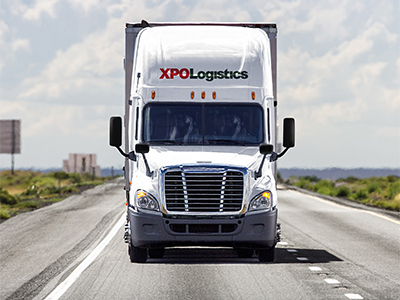New business wins pace strong Q1 for XPO Logistics

First quarter earnings results for freight transportation and logistics services provider XPO Logistics, which were released late yesterday, were largely positive.
Revenue for the quarter, at $3.54 billion, was down 0.3 percent annually, although it was up $122.6 million when excluding the first quarter 2016 revenue from its former North American truckload unit (part of its late 2015 acquisition of Con-way).
And net income attributable to common shareholders was $19.5 million, with earnings at $0.16 per share, matching Wall Street estimates, compared to a net loss of $23.2 million, or $0.21 per share a year ago.
First quarter EBITDA came in at $290 million, minus $21 million in integration and rebranding costs, which marked a 16 percent annual increase. XPO said that its full-year 2017 adjusted EBITDA target is pegged at a minimum of $1.35 billion for 2017 and a minimum of $1.575 billion for 2018.
For quarterly results by business segment, XPO saw solid gains, including:
- Transportation total revenue at $2.28 billion was off 0.9 percent annually compared to last year’s $2.30 billion, due to the Con-way Truckload divestiture, with Con-way Truckload accounting for $128.8 million in revenue for the first quarter of 2016. XPO said organic growth was driven by its last-mile and truck brokerage segments and offset by lower revenue in expedited and global forwarding and unfavorable exchange rates. XPO’s less-than-truckload segment had a 390 basis point operating ratio improvement, with operating income up 49 percent annually at $95.5 million.
- Logistics total revenue at $1.30 billion was up 3.1 percent annually, due in large part to gains in European contract logistics, specifically e-commerce and cold chain contracts in the U.K., the Netherlands, and Italy and North American gains in e-commerce, food and beverage, and industrial sectors
“We are on a role with sales,” said Brad Jacobs, XPO Chairman and CEO, in an interview. “XPO signed the largest contract in our company’s history on any business line with an intermodal contract with a Fortune 50 company, and we also won a large contract to manage reverse logistics in North American for a global consumer brand. We closed a record $716 million in new business for the quarter, which is up 57 percent from $429 million a year ago, and our global sales pipeline is up to about $3 billion.”
With XPO no longer having an asset-based truckload business, Jacobs said on an “apples to apples” basis, revenue for the XPO transportation segment grew 4.4 percent annually, adding its LTL segment’s performance was “stunning,” with its aforementioned 49 percent operating income increase.
And the XPO Last-Mile group, he said, led the path on revenue growth, up 16 percent annually at $207 million, due its market-leading position for last-mile delivery of heavy goods and e-commerce strength, and the overall outsourcing trend by retailers for both last-mile and heavy goods.
Globally, XPO’s European supply chain business grew 12 percent annually, with the U.K. growing fast with e-commerce wins and XPO being the largest provider of outsourced e-fulfillment services in Europe.
“If a retailer has plans to grow online sales, we are getting calls,” Jacobs said, “and we are winning more e-commerce business in North American supply chain, including customers headquartered in Europe. We are pressing our e-commerce advantage in supply chain and last-mile.”
With e-tailers growing around 20 percent annually in many cases, Jacobs said XPO is determined to be their solutions provider and looks at itself as enabling growth for customers to help navigate the evolution from bricks and mortar to e-commerce. What’s more, he said that between 2018-2020 it is expected that more than 20 percent of heavy goods will be sold online.
When asked what is needed to keep growth for XPO at current levels moving forward, Jacobs explained that XPO is outpacing end markets globally, in part due to its leading positions, with business coming to the company.
“Globally, transportation markets are lukewarm, while contract logistics is hot,” said Jacobs. “The North American truckload market appears to be loose except for normal retail spikes for produce and some other things. Industrial freight trends have been stronger than retail, and that has been a plus for LTL volumes, not just for us but our customers, too. In Europe, transportation markets are also sluggish, although we are starting to see some bright spots in France. Contract logistics have competitive dynamics with retail customers, and they have more demanding expectations from the consumer so that is driving changes in how they manage their supply chain and retailers are outsourcing more of their logistics to specialists like us. In fact, we are opening a new contract logistics site, on average, every two weeks in North America and at a similar pace in Europe. We expect organic growth in contract logistics will accelerate in the second quarter in large part to these e-commerce trends.”

Article Topics
News & Resources
Latest in Materials Handling
RoboGeorgia launches to make Georgia a leading robotics and automation hub Vehicle-mounted computers: Beyond rugged New packaging idea for the cold chain Autonomous mobile robots (AMRs) offer modern solution to challenges of traditional farming Hyster-Yale Group provides students with real-world AI experience in 2024 Kellogg Design Challenge KION Group’s board extends CEO Rob Smith’s contract by five years UniCarriers Forklift joins Quality Equipment in opening celebration of new location More Materials HandlingAbout the Author
Subscribe to Materials Handling Magazine

Find out what the world's most innovative companies are doing to improve productivity in their plants and distribution centers.
Start your FREE subscription today.
April 2024 Modern Materials Handling

Latest Resources










